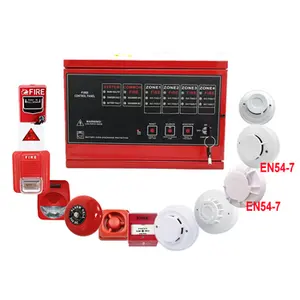What is a Fire Alarm Battery?
A fire alarm battery is a power source used in fire alarm systems to ensure their continued functionality in the event of a power outage. Fire alarms are critical components of building safety, providing early warning in the case of a fire, allowing occupants to evacuate promptly and minimizing potential damage. The fire alarm batteries are typically rechargeable and designed to provide backup power for the alarm system when the primary power source, such as electricity from the grid, fails. This is crucial because fires can occur at any time, and it's essential that the fire alarm system remains operational even during power interruptions.
The type of battery used in a fire alarm system can vary, but common options include sealed lead-acid batteries or lithium-ion batteries. These batteries are chosen for their reliability, long life, and ability to provide a stable power supply for the alarm system. It's important to regularly test and replace fire alarm batteries as part of routine maintenance to ensure that the fire alarm system functions correctly when needed. Some modern fire alarm systems may also have features that alert building occupants or maintenance personnel when a fire alarm battery replacement is needed or when there's an issue with the power supply.
Features of Fire Alarm Batteries
Fire alarm batteries come in various capacities, typically measured in ampere-hours (Ah). Higher capacity batteries can provide power for longer durations during an outage. The most common types of batteries used in fire alarm systems are sealed lead-acid (SLA) batteries, including gel and AGM (Absorbent Glass Mat) varieties. These batteries are preferred for their reliability, low maintenance, and ability to provide consistent power. Fire alarm batteries are typically designed to match the voltage requirements of the fire alarm system they're intended for. Common voltages include 12 volts (V) and 24V DC. They are rechargeable, allowing them to be replenished once mains power is restored. This ensures continuous availability of backup power in case of subsequent outages. Most fire alarm batteries are sealed to prevent leakage of electrolyte, making them safe for use in various indoor environments. Sealed batteries also eliminate the need for maintenance tasks like electrolyte level checks and refills.
How to Change Fire Alarm Battery
Changing the battery in a fire alarm is a straightforward process, but it's important to follow specific steps to ensure the continued reliability of the fire alarm system. Here's a general guide on how to change battery for fire alarm. Before starting, refer to the user manual or guidelines provided by the manufacturer of the specific fire alarm system, as procedures may vary. Identify the type of battery used in the fire alarm system. Common types include sealed lead-acid batteries or lithium-ion batteries. If the fire alarm system is connected to the electrical power supply, turn off the power to the system. This is usually done at the circuit breaker or by unplugging the system if it has a power cord.
Open the cover or panel that provides access to the battery compartment. This may involve removing screws, sliding a latch, or using a tool, depending on the design of the fire alarm. Identify the existing battery within the compartment. Note its orientation and how it is connected. Disconnect the old battery from its terminals. In some cases, it might be connected with a clip, screws, or a simple plug. Be cautious and gentle to avoid damaging the wiring. Follow local regulations for the proper disposal of batteries. Many communities have designated recycling centers or drop-off locations for used batteries.































 浙公网安备 33010002000092号
浙公网安备 33010002000092号 浙B2-20120091-4
浙B2-20120091-4